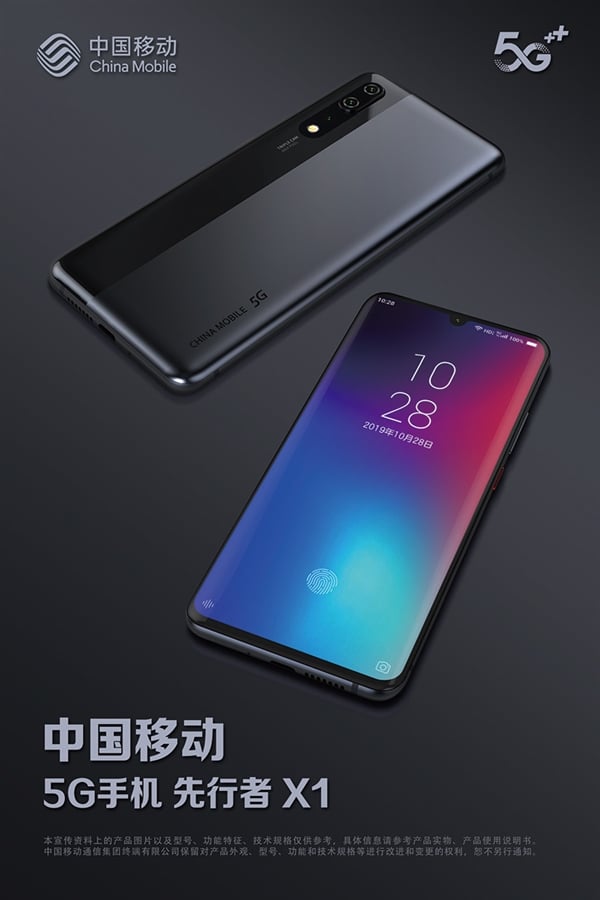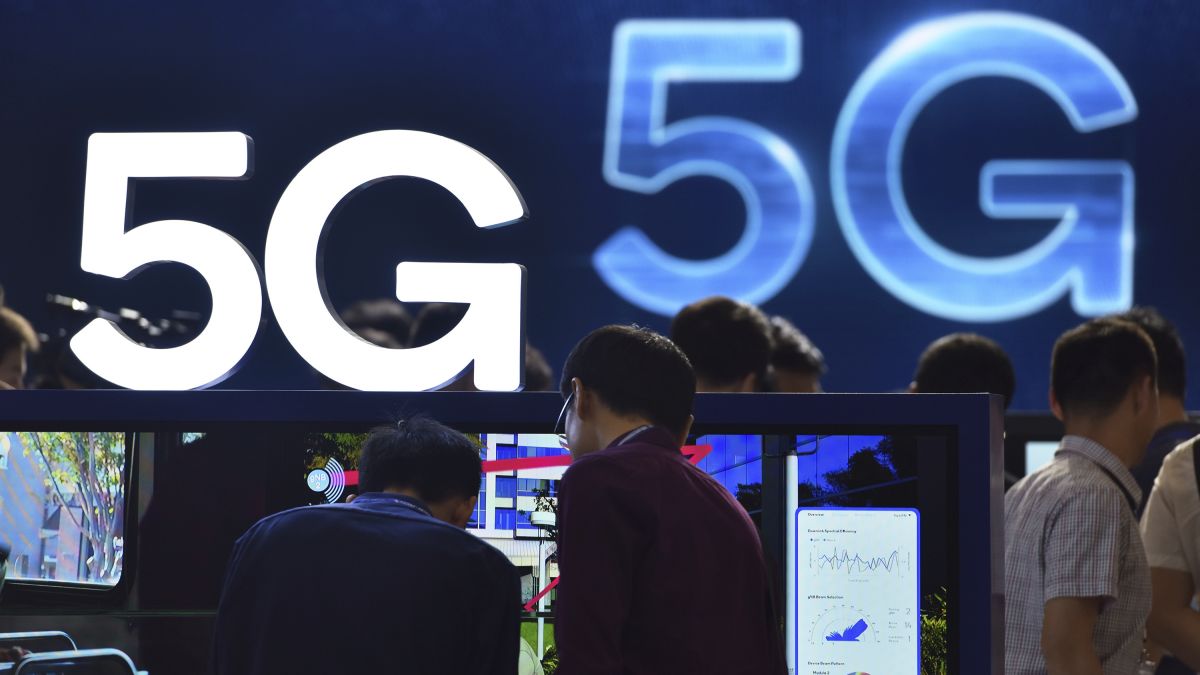China’s big 3 mobile operators have 9 Million 5G subscribers in advance of the service; Barron’s: China to lead in 5G deployments
According to Beijing News, the three major (state owned) China mobile network operators have already signed up 9 million advance orders for their yet to be launched 5G service. As of October 5th, China Mobile’s 5G subscribers have reached 5.32 million, China Unicom has 1.75 million, China Telecom has 1.76 million, and the total number of committed 5G users is nearly 9 million.
The three China network operators haven’t set a date for the start of service, but will reportedly commence simultaneously, most likely later this month of October. However, there are not many 5G smartphones (only two or three models) and no other endpoints (none announced yet) available from the three major China network operators. The preferential price is between 150 yuan and 550 yuan.
On September 20, Xu Ximing, deputy general manager of the marketing department of China Mobile Group Corporation, said at the China Mobile 5G+ Innovation Cooperation Conference that China Mobile is accelerating the pace of 5G commercialization. The 5G package will be officially released in October, including basic packages and CPE packages. And upgrade plans for old users. Customers will enjoy the “three different fast” login to the 5G network, that is, the 5G terminal does not need to change the card, does not need to change the number, does not need to register, and multi-channel fast order 5G network service.
- The China Unicom prices web page shows that the current campaign supports two mobile phones, Samsung Note 10+5G version offers 500 yuan, and vivo’s iQOO Pro 5G version offers 400 yuan. Telecom’s purchase discounts are 150 yuan for iQOO Pro, 300 yuan for ZTE Axon 10 Pro, and 550 yuan for Samsung Note 10+.
- For China Mobile’s preferential prices, Xiaomi 9 Pro 5G version is offered for 300 yuan, China Mobile’s pioneer X1, Samsung Note 10+ 5G version offer is 500 yuan. China Mobile told the Beijing News that more 5G models will be added in the future.

China Mobile Pioneer X1 is powered by a Qualcomm Snapdragon 855 chipset, a 6.47-inch AMOLED display with a waterdrop notch. The display supports FHD+ resolution and also houses an on-screen fingerprint scanner. Housed inside the waterdrop notch is a powerful 20MP camera.
…………………………………………………………………………………………………………………………………………………………………………………………………………………
Note: Although Samsung continues phone sales in China, last week the handset maker ceased its mobile phone production operations in China as it closed its last factory in the country, according to Reuters.
………………………………………………………………………………………………………………………………………………………………………………………………..
China’s 5G network coverage is progressing rapidly and the 5G network is increasingly equipped with a formal commercial foundation. Recently, the official statistics of the Beijing Municipal Bureau of Economics and Information Technology state that the three major network operators have completed more than 8,800 5G base stations in Beijing, covering areas along Chang’an Avenue, the World Expo, CCTV Broadcasting Center, and Shougang Park.
According to a message released by the Beijing Communications Administration, it is expected that by the end of 2019, Beijing will build more than 10,000 5G base stations. According to the current construction progress, the number of 5G base stations in Beijing is expected to reach 12,000 by the end of the year. Among the other three first-tier cities, Shanghai plans to build 10,000 5G base stations in 2019 and 20,000 5G base stations in 2020; Guangzhou proposes to complete no less than 20,000 5G base stations in 2019, and 5G will be built in 2021. The base station is 65,000; the plan for Shenzhen is to build 15,000 5G base stations by the end of 2019.
With the spread of 5G networks, innovative applications in various 5G environments are emerging and even landing. On September 25, Daxing International Airport was officially opened. Eastern Airlines, Beijing Unicom and Huawei jointly released a 5G-based smart travel integrated service system at Daxing International Airport. Under the system, the user does not need to present the ID card and the QR code as usual, and only needs face recognition to complete the travel process such as ticket purchase, check-in, check-in, security check, and boarding.
China’s government is partially subsidizing 5G deployments as we note in several paragraphs below:
- The Shenzhen city government is offering to pay operators RMB10,000 ($1,398) for every standalone 5G base station deployed, with a maximum payout of RMB150 million ($20.9 million). Its 5G plan issued last month promises support for site acquisition and subsidies for base station electricity costs. The tech-dominated Chinese city, home to Huawei, ZTE and Tencent, plans to install 15,000 5G base stations by the end of 2019 and 45,000 by next August (more on this below).
- Almost every Chinese city or provincial government has a 5G development plan. While many are light on specifics, some reveal big ambitions. For example, the government of Zhejiang, the wealthy province near Shanghai, expects to have 30,000 base stations next year. It plans to complete its 5G rollout by 2022, by which time its coverage will “lead the country.”
- The north-west province of Shanxi — not known for its advanced tech industries — has also made 5G a top priority. It has bench marked its 5G rollout against other provinces and, like Zhejiang, has set a target of 30,000 base stations by 2022. And the city is also offering subsidies for base station power costs and help in site selection.

………………………………………………………………………………………………………………………………………………………………………………………………..
From an article titled, “The Real 5G Winner Could Be China,” in the October 7, 2019 print edition of Barron’s:
Multiple Wall Street analysts are getting more optimistic about China’s 5G build out. For instance, Rosenblatt Securities notes that local governments in the Asian country are providing subsidies to “speed up 5G network deployments.” As a result, Rosenblatt says, more than 300 cities in China will have 5G networks by the end of next year. Even Hall, the Goldman Sachs 5G skeptic, expects 120 million 5G smartphones to ship next year, largely because of China’s aggressive build out.
In a report this past week, Piper Jaffray analyst Harsh Kumar cited a Chinese think tank that sees China-based companies spending $411 billion on 5G networks from 2020 to 2030. Of the 600,000 5G base stations expected to be rolled out worldwide next year, Kumar says half will be deployed in China: “We expect 2020 global [5G] deployments to largely be driven by the Chinese market.”
5G may come together slowly in the U.S. market, but China is serious about winning the race.
………………………………………………………………………………………………………………………………………………………………………………………………………….
References:
https://tech.sina.com.cn/t/2019-10-06/doc-iicezzrr0343842.shtml
https://www.lightreading.com/asia-pacific/china-telcos-rack-up-9m-5g-advance-subs/d/d-id/754643?
https://www.barrons.com/articles/the-real-5g-winner-could-be-china-51570228459
https://www.wsj.com/articles/in-the-race-to-dominate-5g-china-has-an-edge-11567828888
2 thoughts on “China’s big 3 mobile operators have 9 Million 5G subscribers in advance of the service; Barron’s: China to lead in 5G deployments”
Comments are closed.



China Mobile, China Unicom and China Telecom, as well as China Broadcasting Network, were each awarded a licence to run commercial 5G mobile services, according to the Ministry of Industry and Information Technology (MIIT).
The award of licences is expected to enable China to move ahead in the global race to deploy telecoms infrastructure that will help power the industrial internet, autonomous driving and smart cities, among a range of advanced mobile applications.
While South Korea, the US, Australia and the UK have launched initial commercial 5G services in the second quarter, the scale of China’s market is likely to dwarf the combined size of those economies, negating any first-mover advantage.
“This marks China’s official entry to the 5G era,” Huawei Technologies, which has up to a 50 per cent share of the country’s telecoms equipment market, said in a statement on Thursday. “Huawei will fully support Chinese operators to build 5G [networks] with comprehensive end-to-end 5G capabilities. We believe that in the near future, China’s 5G will lead the world.”
https://www.scmp.com/tech/big-tech/article/3013302/china-awards-5g-licences-countrys-major-telecoms-network-operators
China now has 10M advance of 5G service subs:
Chinese consumers are scrambling to be the first batch of users of 5G mobile services, with more than 10 million having pre-ordered mobile package services for the fifth-generation wireless technology.
According to early data from the country’s three major telecom carriers, more than 10 million consumers had applied for 5G mobile package services by 9:25 am on Wednesday, October 9th.
Specifically, 5.92 million users pre-ordered the data packages from China Mobile, the nation’s largest telecom operator by mobile subscribers, 2 million ordered them from China Unicom and 2.08 million from China Telecom.
The 10 million level marks an 88 percent jump from the data as of Sept 30. By then, more than 5.3 million users had pre-ordered the services.
So far, the three major carriers have not officially launched their 5G data packages yet and they have all offered discounts of up to 30 percent to attract early customers.
The enthusiasm for 5G mobile services came after about 219,000 units of smartphones were shipped in China in August, data from the China Academy of Information and Communications Technology showed.
In July, the shipments of 5G smartphones were 72,000 units. That was about a month after China granted the licenses for commercial use of 5G services on June 6.
Xiang Ligang, director-general of telecom industry association Information Consumption Alliance, said the prices for official 5G data packages are likely to be unveiled soon.
“Some of the consumers who have pre-ordered the 5G mobile services may not buy 5G smartphones yet, but their eagerness to try new things can be seen from their enthusiasm,” Xiang explained.
China Mobile has attracted more 5G pre-orders than its two smaller rivals so far, partly because it currently has the largest number of 4G users in the country, he said.
The big three mobile carriers said that current telecom users do not need to change their SIM card and mobile numbers. After purchasing a 5G smartphone, they are able to upgrade their previous 4G package to a 5G package.
Employees at the Beijing branch of China Telecom said earlier that the price of a monthly 5G data package could range from 199 yuan ($28) to 599 yuan.
Fu Liang, an independent analyst who has been following the telecom industry for more than a decade, said a key hurdle in 5G adoption was the price of 5G smartphones and data packages, along with the 5G support network. At this time, there is limited coverage of the 5G network around the world.
“But Chinese companies are adopting aggressive strategies to extend 5G coverage and lower the prices. The more quickly 5G networks are constructed and the cheaper the smartphones and data packages are, the easier it will be to convince people to purchase them,” Fu said.
China Telecom said it will work along with key smartphone vendors to unveil 5G handsets priced under 2,000 yuan in the first half of next year.
At the same time, China Telecom announced it would partner with China Unicom to build a nationwide 5G network, as they aim to accelerate the rollout of 5G by reducing construction costs.
https://www.chinadaily.com.cn/a/201910/10/WS5d9e68b1a310cf3e3556f894.html